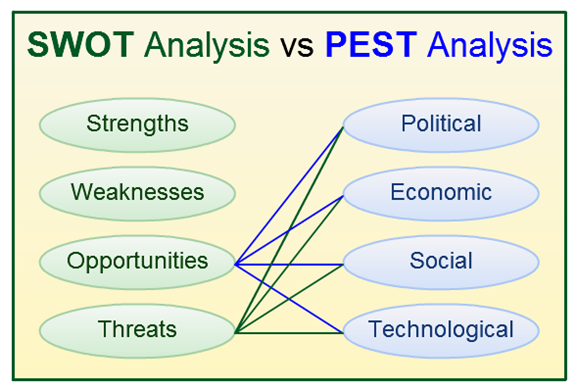Table of Contents
Both internal and external environment affects the operation of a firm. The management has to consider the impact of the microenvironment on business planning. The influence of the macro-environment also affects the organizations’ strategic planning. The SWOT and PESTLE analyses provide information on the internal and external factors. The information obtains from these factors affect the firms’ decision-making. The information is useful in launching a new product in the market. It is also useful in expanding business operations. The companies can achieve a competitive advantage by the right analysis in planning. Hence, the organizations must be careful in conducting the SWOT and PESTLE analyses. This article by experts of top dissertation writing services firm aims to provide what is SWOT and PESTLE analysis. Furthermore, the article will provide the differences between the SWOT and PESTLE analyses.
SWOT Analysis:
The SWOT analysis helps in identifying the firms’ market position in the microenvironment. The SWOT analysis is an abbreviation of the Strength, Weaknesses, Opportunities, and Threats. Firstly, it is a flexible analysis and application is in various other business operations of a firm. Businesses are using it to launch a new product or project. By using this analysis, companies assess their competitiveness against their competitors. Secondly, the strength factor helps in assessing the strength competencies of a firm.
Decisions on the Business Activities
The tool evaluates the advantages and disadvantages of decisions on the business activities. It is applicable in launching a new product of the company which also helps in the promotional activities, and awareness of using a product. Firstly, it provides user’s to express their experiences of the company’s market offerings. Secondly, these tools make the success and failure of a market offering predictable. Thirdly, It is a systematic and detailed analysis used in launching a new product or project. Moreover, these tools assist the planners of the organizations in being conscious, aware, and careful. It provides the analysis of the internal-external factors on business. Any minor or significant changes in these factors impact the business operations. It is a complete assessment of the business operations in the micro-environment.
PESTLE Analysis:
The PESTLE analysis helps in identifying the external environment impact. The impact effects in expanding the business operations. It is an abbreviation of the Political, Economic, Social, Technological, Legal and Environmental factors. It is a non-conforming analysis that is only used in the firm for expansion purposes. The political factor helps in identifying the politics of the external environment. It provides the assessment of the impact of political decisions. The decisions impact business expansion and development.
Country’s Legislation in Business Development
The legal factor assesses the country’s legislation in business development and growth. The environmental factor identifies the natural environment both national and global. As environment influences the business expansion. Firstly, The tool evaluates the impact of the macroenvironment’s decisions on the business. Secondly, It is applicable in business expansion activities. Thirdly, The analysis provides the experiences of the users of the external environment. Moreover, It makes the success and failure of a market offering predictable in the macro-environment. It is a systematic and detailed analysis. These tools assist the planners of the organizations in being conscious, aware, and careful. It provides an analysis of the external factors of the business. Any minor or significant changes in these factors impact the business operations. It is a comprehensive assessment of the business operations in the macro-environment.
Difference between SWOT and PESTLE Analysis:
Both the analysis tools are used in the strategic decision-making of the business activities. The only difference between the analysis is the consideration of the factors. The SWOT analysis considers both internal and external factors in the decision-making. While PESTLE analysis only considers the external macro-environment factors in the decision-making. Hence, organizations cannot identify their relevant strengths and weaknesses in the PESTLE analysis.
While the PESTLE analysis conducts in-depth and detailed research. The research focuses on external environmental factors. But SWOT analysis does not conduct thorough and in-depth research. The research does not consider external environmental factors. So the recommendation is to conduct the PESTLE analysis first. After PESTLE incorporate the findings in the SWOT analysis.

Conclusion:
Both the SWOT ad PESTLE analyses are helpful tools. These help in evaluating the advantages and disadvantages of the major decisions. They assist planners to be conscious, aware, and careful in planning. As a result, They provide an analysis of the internal and external factors of the business. These analyses provide the impact of the internal and external environment in planning. They make the success and failure of a market offering predictable. Any minor or major changes in these factors impact the business operations. They provide complete detail of these impacts on the business activities. It is a comprehensive assessment of the business in the micro and macroenvironment.
References:
SWOT vs PESTLE, S., 2021. SWOT Analysis and PEST Analysis – When to Use Them. [online] Creatley. Available at: <https://creately.com/blog/diagrams/swot-analysis-vs-pest-analysis/> [Accessed 19 September 2021].


